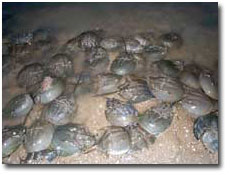

The American Horseshoe Crab is a unique and valuable marine invertebrate. It provides both ecological and economic benefits to Maryland and other coastal states of the mid-Atlantic region. Since the 1990's, concern over the exploitation of this important species has been expressed by government agencies, conservation organizations and fisheries interests.
Currently, various user groups throughout the region use horseshoe crabs. Watermen harvest the crabs as bait to catch several commercial fish species including eel (Anguilla rostrada) and whelk (Busycon spp.). The biomedical industry uses a protein in the crab's blood to test the safety of other medical products. In addition to these economic benefits, horseshoe crabs play an important role the coastal ecology in the Mid-Atlantic region.
Horseshoe crab populations occupy an important ecological niche in estuarine and coastal habitats along the Mid-Atlantic coast. Adult horseshoe crabs are food for sea turtles, sharks and terrestrial species such as raccoons and foxes. Their eggs are a vital food source for hemispheric shorebirds.
Hemispheric shorebirds feed on the superabundance of horseshoe crab eggs deposited in the sand on mid-Atlantic beaches each spring. Rich in fat and protein, horseshoe crab eggs enable these migratory shorebirds to continue their northern migration to Arctic breeding grounds.
The concentrations of shorebirds that come to feed on the eggs of the horseshoe crab are also important to the ecotourism industry in the Delaware Bay. The shorebirds attract recreational birders from all over the world bringing important tourist dollars to the region.
Maryland and other States are tasked with managing and conserving this valuable resource. Specific conservation efforts are underway to better understand and manage horseshoe crabs throughout the region. The ultimate goals of these efforts are maintaining the stability of the region's horseshoe crab population, its role in the coastal marine ecology (i.e., shorebird connection) and its availability for use by different stakeholders over the long-term.
To learn more, visit the links on the left.